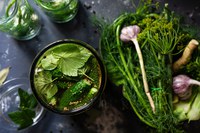Prairie Fare: Don’t get yourself in a pickle when canning pickles
(Click an image below to view a high-resolution image that can be downloaded)
Have you ever been “in a pickle”?
As I was pondering this week’s column, I wondered where that expression originated.
Being in a pickle is not a good thing, by the way. Basically, this means you are in a situation similar to “being up to your neck in an acidic brine.” No one likes that kind of painful situation.
The “in a pickle” expression was used in a play by Shakespeare in 1610. The Oxford Dictionary pushes the history of the expression to the 1500s.
In earlier times, being in a pickle meant the person was heavily intoxicated.
The process of fermentation dates back hundreds, if not thousands, of years. Pickling is among the popular food preservation processes that grew out of early fermentation.
Pickling and fermenting differ from each other. Pickling typically uses vinegar, which is a fermented food. Vinegar can be produced by fermenting barley, corn, sugar or fruit, such as apples. Alcohol is produced first, and then the alcohol is converted to acetic acid.
In the process of making wine, perhaps our very early food scientists made vinegar by accident. Someone may have decided to drop some vegetables in the acidic liquid to see what would happen, and they enjoyed the sour flavor and unique texture.
Perhaps the early fermenters observed an animal consume fermenting grain or fruit. The animal may have “wobbled around” after indulging. Someone decided to give the food or beverage a try.
We do not recommend tasting foods or beverages to determine if they are safe, by the way.
Fermentation is a process where bacteria, yeasts or other organisms convert sugars to alcohol or acid.
Wine, sourdough bread, sauerkraut, yogurt, kimchi and many other foods are products of fermentation. Pickles can be fermented, where acid is formed naturally from sugars, or they can get their acidic flavor through the use of a vinegar-based brine that includes salt and other flavors. Distilled (white) vinegar and apple cider vinegar are two popular types.
July is National Pickle Month. At this time of summer, cucumbers and other vegetables are becoming ripe and ready for picking and pickling.
Don’t get yourself in a pickle when canning pickles. Put on your scientist hat. Many foods can be pickled, including vegetables, fruits, fish, eggs and other foods.
When you purchase vinegar for pickling and canning in shelf-stable jars, be sure the label says “5% acetic acid” or “5% acidity” on the vinegar container. Sometimes the vinegar in the “canning section” of grocery stores and other retail stores is at 4% acetic acid. You might need to go to another section of the store to find a vinegar with 5% acetic acid. However, do not substitute “cleaning vinegar” in your pickling processes. That type of vinegar is too high in acidity for use in food.
Using a vinegar in canned pickled products with an acidity level below 5% can result in spoiled, unsafe food.
If you are making refrigerated items using vinegar, such as salad dressings, you can safely use the type of vinegar with a lower amount of acetic acid.
As I was perusing a store recently, I noted that the vinegar in the canning section was not at the recommended acidity. Sometimes, flavored “pickling vinegars” may have an even lower amount of acetic acid and added flavorings.
Be sure to use research-tested pickling recipes for shelf-stable pickles. See the NDSU Extension fermentation and pickling resources available at www.ag.ndsu.edu/food by clicking on “Food Preservation and Wild Game Safety” and then “Pickle and “Ferment.” You can learn to make sauerkraut and a variety of pickled products.
Pickled egg recipes, such as the following one, are available from the National Center for Home Food Preservation. This recipe will retain its safety for up to four months in your refrigerator when stored in the brine. This protein-rich addition to summer menus will add some zing. We do not have a recipe for pickled eggs that can be canned safely, though.
Dilled Pickled Eggs (not for canning)
12 eggs
Use similar-sized eggs for consistent hard-cooking. Use this process to avoid getting green halos on the eggs from overcooking. Place the eggs in a single layer on the bottom of a pot and cover with cold water. The water should be about an inch or so higher than the eggs. Cover the pot with a lid and bring the pot to a rolling boil. Remove from the heat and allow to stand for 10 to 12 minutes. Drain the hot water and run cold water over the eggs. To peel, crackle the shell by tapping the egg with a spoon or other utensil.
Brine
1 1/2 cups white vinegar (5% acidity)
1 cup water
3/4 teaspoon dill weed or dill seed
1/4 teaspoon white pepper or whole peppercorns
1 tablespoon pickling and canning salt
1/4 teaspoon mustard seed
1/2 teaspoon minced onion
1/2 teaspoon minced garlic or 1 peeled garlic clove
Bring brine ingredients to a boil, reduce the heat and simmer for five minutes. Pack peeled, hard-cooked eggs loosely into a warm, pre-sterilized wide-mouth glass quart jar. Be sure to have enough pickling solution to completely cover the eggs.
Pour the pickling solution over the eggs in the jar, cover and refrigerate immediately. Allow two weeks for the eggs to develop flavor and enjoy pickled eggs within three to four months. Keep eggs refrigerated at all times. Makes 12 servings. We do not have nutrition information available.
(Julie Garden-Robinson, Ph.D., R.D., L.R.D., is a North Dakota State University Extension food and nutrition specialist and professor in the Department of Health, Nutrition and Exercise Sciences. Follow her on Twitter @jgardenrobinson)
NDSU Agriculture Communication – July 20, 2023
Source: Julie Garden-Robinson, 701-231-7187, julie.garden-robinson@ndsu.edu
Editor: Elizabeth Cronin, 701-231-7881, elizabeth.cronin@ndsu.edu




